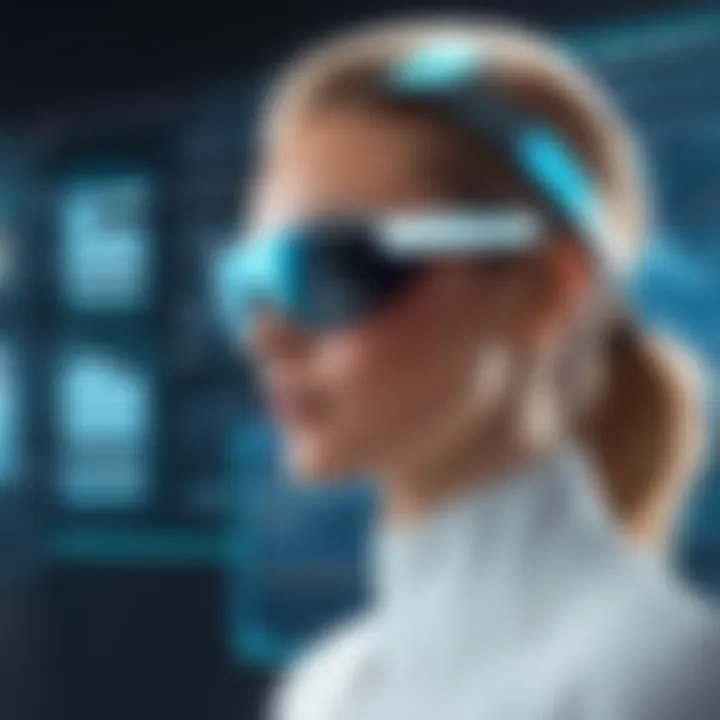Exploring OCR Ease Software for Document Management


Intro
In today's fast-paced digital landscape, the ability to swiftly convert scanned documents and images into editable text has become an invaluable asset across numerous industries. Organizations are under continuous pressure to streamline workflows, and OCR (Optical Character Recognition) technology stands at the forefront of this transformation. Among the various solutions available, OCR Ease Software embodies these advancements, presenting a user-friendly approach to digital document management.
This comprehensive exploration seeks to illuminate the intricacies of OCR Ease Software, investigate its fundamental features, and evaluate the different tools available in the market. In doing so, we aim to provide decision-makers, IT professionals, and entrepreneurs with the insights necessary to make informed decisions about OCR technologies that can enhance operational efficiencies within their organizations.
As we delve deeper into this topic, we will specifically focus on the core features that define OCR Ease Software, its user experience, and how it stacks up against competing solutions. With these insights, readers will not only grasp how these technologies work but also understand the significant advantages they can provide in everyday tasks like data entry, archiving, and content retrieval.
Prelude to OCR Ease Software
The landscape of documentation and information management is evolving at an unprecedented pace. As organizations strive to streamline their workflows, OCR Ease Software has become a pivotal tool in converting scanned documents into editable text. This technology not only enhances operational efficiency but also unlocks new avenues for digitization, making it essential for industries ranging from healthcare to finance.
The significance of OCR Ease Software cannot be overstated. By enabling a seamless transition from physical to digital, it empowers businesses to reduce paper clutter and improve accessibility. Moreover, the capabilities of OCR technology go beyond mere text recognition; they lay the groundwork for advanced data analysis and integration, boosting the decision-making process.
Definition of OCR Technology
Optical Character Recognition (OCR) is a technology that interprets different types of documents, including scanned paper documents, PDFs, and images captured by a digital camera. Simply put, it transforms images of text into machine-readable text. At its core, OCR takes the complexity of physical documents and reduces it to a format that can easily be manipulated, searched, and stored.
The technology employs various methods, such as pattern recognition, to decipher fonts, handwriting, and even the quirks of human input. It eliminates the bottleneck traditionally associated with data entry, thereby saving time and reducing costs associated with manual transcription.
Historical Development of OCR
The journey of OCR technology is fascinating and represents a growth trajectory that echoes advancements in computing. The first instances of automated text recognition emerged in the late 19th century. However, it wasn’t until the 1950s that significant strides were made with the advent of the first computer-based OCR systems. These early machines were limited, often functioning as little more than glorified typewriters.
By the 1970s, the technology began to materially improve, primarily fueled by innovations in hardware and software. Notable breakthroughs included the introduction of neural networks and the widespread usage of scanning devices. These advancements allowed for a wider range of fonts and improved accuracy, setting the stage for today’s sophisticated OCR solutions.
Today, OCR software is harnessed alongside AI and machine learning, enabling it to learn and adapt to varied types of documents, which has further broadened its applicability. The historical evolution outlines not just the tool's ability to interpret text but also serves as a reflection of technological advancement as a whole.
Core Functionality of OCR Ease Software
When delving into OCR Ease Software, one must first grasp its core functionality. This underpins not just how the software operates, but also its significant benefits across various applications. The capability to transform physical documents into editable text is not just convenient; it can lead to increased productivity, reduced manual errors, and ultimately a more streamlined workflow.
Document Scanning Process
The document scanning process is the initial stage in OCR functionality. It begins with capturing the image of a document, whether it be a printed page, a handwritten note, or even a complex graphic. This stage is crucial because the quality of the scan can directly influence the accuracy of text recognition.
Typically, users will use a scanner, which might be a dedicated one or a multifunction printer, to create a digital image of the physical document. It's important to note the resolution at which the scanning occurs. A higher resolution often yields better results, but it can also increase file sizes, creating a trade-off that users must consider.
Once scanned, the software often allows users to preview the image, checking for clarity. Any defects or blurriness can lead to significant challenges down the line when it comes to text recognition. In addition, many OCR systems offer features to automatically adjust the scanned images for optimal readability, further enhancing the quality of the input data.
Text Recognition Algorithms
Moving on from scanning, the next big player in the realm of OCR Ease Software is text recognition algorithms. These algorithms are the unsung heroes behind the scenes, transforming the scanned images into editable text.
Several types of algorithms exist, each with varying levels of sophistication. The most superior are generally neural network-based models, which leverage complex computations to identify characters and words in a scanned image. They analyze patterns, not just in single characters but also in their context—like how a word appears in a sentence.
An essential aspect of these algorithms is their ability to learn and adapt. As users engage with the software—correcting mistakes, for example—the system can improve its accuracy over time. This continuously evolving accuracy is fundamental, especially in environments where text can be inconsistent, such as in medical or legal documents.
Exporting and Editing Documents
After the arduous processes of scanning and recognizing text, users arrive at the exporting and editing phase. This stage is what seals the deal for many professionals. It’s not enough to extract text; it must also integrate seamlessly into existing workflows.
Usually, OCR software allows for a variety of export options. Users can often save documents in formats like Word, PDF, or plain text, catering to different needs. The option to edit directly within the OCR software before final export is a notable benefit as it affords users the ability to correct errors on the fly.
Furthermore, advanced OCR tools offer formatting retention, ensuring that tables, lists, and other structured elements are preserved in the export. This not only enhances accessibility but also saves time that would otherwise be spent reformatting.
In summary, understanding the core functionalities of OCR Ease Software— from document scanning to text recognition algorithms, and finally to exporting and editing—is essential. This knowledge empowers decision-makers, IT professionals, and entrepreneurs to leverage OCR technology effectively, optimizing their operations and making informed choices as they pursue document management solutions.


Applications of OCR Ease Software
The applications of OCR Ease Software represent a pivotal aspect of its functionality. Recognizing where and how this technology integrates across different sectors can provide insights into its versatility and practical benefits. As organizations continue to rely on digital documentation, the need for robust OCR solutions becomes clear. Whether it's streamlining workflows, enhancing data accessibility, or optimizing operational efficiency, the impact of OCR software is far-reaching and significant.
Usage in Business Environments
In the realm of business, the adoption of OCR technology can transform the way organizations interact with their documents. Companies often drown in a sea of paper, which can lead to inefficiencies and errors. With OCR Ease Software, businesses can digitize invoices, contracts, and other critical documents with precision. This not only helps in reducing storage costs but also enables quicker retrieval of information.
Consider a financial institution dealing with thousands of documents daily. By employing OCR technology, they can extract data from scanned forms, making it easy to input information into databases without manual effort. For instance, imagine a scenario where a bank processes loan applications. Instead of having staff enter data by hand, which is tedious and prone to mistakes, they can automate this process using OCR. This streamlining contributes to faster decision-making and improved customer satisfaction.
Key Benefits for Businesses:
- Increased Efficiency: Automation of data entry saves time.
- Cost Savings: Reduces physical storage needs and paperwork.
- Enhanced Accuracy: Minimizes human error in data processing.
Relevance in Healthcare Settings
Healthcare is another domain where OCR Ease Software can be invaluable. Hospitals and clinics handle vast amounts of paperwork: patient records, treatment plans, and insurance claims, to name a few. By utilizing OCR technology, healthcare providers can digitize these documents, making them easier to manage and analyze.
For example, consider a medical office where physicians are inundated with handwritten notes and forms. Using OCR, they can convert these handwritten inputs into editable, searchable digital formats. This not only facilitates quicker access to patient information but also aids in compliance with health regulations and improves overall patient care.
Impacts on Healthcare Operations:
- Improved Patient Care: Instant access to important patient data.
- Data Sharing: Seamless communication between departments and facilities.
- Regulatory Compliance: Easier documentation for audits and inspections.
Education and Research Applications
In educational institutions and research environments, the role of OCR is crucial for enhancing knowledge dissemination and information accessibility. Textbooks, research papers, and archival documents can be labor-intensive to access when in printed form. OCR technology can convert these materials into formats that are more user-friendly.
For instance, consider a research facility analyzing historical documents. Once scanned, OCR can make these texts searchable, allowing researchers to locate specific information quickly. This drastically reduces the time spent on manual searching, enabling deeper, more thorough examinations of data. Educational institutions can also leverage OCR in classrooms, allowing students to utilize digital resources more effectively, accommodating diverse learning styles.
Benefits in Education and Research:
- Enhanced Research Capabilities: Quick access to archived data.
- Support for Diverse Learners: Adapting materials for students with specific needs.
- Collaborative Opportunities: Easier sharing of resources across academic platforms.
"OCR technology plays a critical role in facilitating the digital transformation across various sectors, helping organizations operate more efficiently and effectively."
By understanding these applications of OCR Ease Software, it becomes evident that this technology is not just a luxury, but a necessity for modern operations across multiple industries. Embracing OCR can lead to significant gains in productivity and a notable improvement in data management.
Comparative Analysis of Leading OCR Software
The selection of OCR software can significantly impact efficiency and operational workflow within organizations. With various options available, a comparative analysis helps to discern not just the features, but also the unique strengths and weaknesses of each product. Understanding these elements is crucial for decision-makers, IT professionals, and entrepreneurs who need solutions that align well with their specific requirements.
Key Players in the Market
In the crowded arena of OCR software, several key players have carved out prominence. Understanding their offerings can substantially inform your decision-making process. Noteworthy contenders include:
- Adobe Acrobat Pro DC: Known for its user-friendly interface and robust editing features, Adobe’s OCR capability integrates seamlessly with its PDF tools, making it a favorite among professionals.
- ABBYY FineReader: This software stands out for its advanced text recognition capabilities and versatility across various formats. It’s often lauded for its accuracy in scanning and converting documents.
- Nuance OmniPage: Recognized for its high-speed processing and enterprise-level features, it allows bulk document conversion, which is ideal for larger organizations or extensive projects.
- Tesseract: An open-source option, Tesseract provides flexibility for developers looking to integrate OCR into customized applications. Its adaptability has made it popular among tech-savvy users.
- Readiris: This software not only performs OCR but also offers document management and collaboration features, providing an all-in-one solution for users.
Each of these players offers distinct advantages and specific use cases. Therefore, knowing their strengths can significantly enhance the selection process.
Feature Comparison
When choosing OCR software, it’s not just about features but about how these features serve a specific purpose in real-world applications. A comparison of features leads to better evaluations. Here are common features to think about:
- Accuracy: Different software tends to excel in various contexts. Adobe Acrobat Pro DC often leads with handwritten notes, while ABBYY FineReader may outshine in multi-language scenarios.
- Speed: The efficiency in processing scanned documents can vary sharply. Programs like Nuance OmniPage are designed for rapid conversion, making them suitable for environments with high volume.
- Integration Capabilities: Compatibility with existing systems is critical. Some, such as Tesseract, easily integrate with other coding ecosystems, whereas others might require additional configuration to ensure smooth implementation.
- Export Form: The ability to export to various formats enhances usability. Readiris and ABBYY FineReader facilitate easy export to popular applications like Microsoft Word or Excel.
"Feature comparison allows users to weigh not only what a software does but also how quickly and efficiently it can meet their needs."
- User Support: Assessing customer service histories and available resources can be an eye-opener. Some of the major players provide extensive support forums and learning materials, which can be beneficial for novice users.
- Cost-effectiveness: Evaluating pricing structures—whether subscription-based like that of Adobe or one-time purchases such as ABBYY—can influence decisions depending on budget constraints.


User Experiences and Case Studies
In the realm of Optical Character Recognition (OCR) software, user experiences and case studies serve as a vital compass. They provide insights not simply into the functional aspects of the software, but also into its real-world applications, benefits, and potential challenges faced by organizations. Gathering feedback and studying specific implementations allows potential users—such as decision-makers, IT professionals, and entrepreneurs—to make informed choices, ensuring these tools align with their unique operational requirements.
One key aspect to consider is how different industries leverage OCR technology to fit their particular needs. This allows us to understand not just what the software can do, but how it solves distinct problems and enhances productivity across various sectors.
Feedback from Business Users
Business professionals often have firsthand experience regarding the effectiveness, efficiency, and potential drawbacks of specific OCR solutions. For many, the leap from paper to digital is not merely a transition—it’s a necessity. Here’s what some users have reported:
- Time Savings: Many users highlight how OCR dramatically reduces time spent on data entry. Tasks that previously took hours or even days can now be handled in a few moments.
- Accuracy and Quality: There is a mixed bag of opinions. Some users praise the improved accuracy of modern OCR solutions, while others note that varying document quality greatly affects results. This insight is crucial: documents with poor print quality or unusual layouts pose challenges, leading to potential inaccuracies that users must be aware of.
- Integration Difficulties: Users also discuss struggles integrating OCR solutions with existing systems. Often, software doesn’t plug-and-play easily, which can introduce bottlenecks.
Overall, user feedback emphasizes the importance of selecting software that not only suits current needs but offers room for growth, reliability, and solid support from vendors.
Case Studies in Healthcare
Healthcare is a domain where OCR has sparked a revolution in document management. Case studies illustrate how hospitals and clinics harness this technology to improve information accessibility and patient care:
- Electronic Health Records (EHR): Many facilities have implemented OCR software to convert paper-based records into digital formats. One notable case involved a mid-sized clinic that transitioned to a paperless system. They saw a 50% reduction in the time required for patient documentation, leading to quicker patient processing and reduced wait times.
- Billing and Claims Processing: A large hospital group documented their experience using OCR for billing. They reported a significant drop in claim rejections. By employing OCR, they could extract critical information from insurance forms quickly and accurately, streamlining the revenue cycle.
- Research and Data Analytics: Several research institutions have explored the application of OCR for extracting data from historical medical records. One university showcased how they utilized OCR to digitize archived records dating back to the early 20th century, enabling researchers to conduct extensive data analysis that was previously impossible.
These case studies not only highlight the transformational potential of OCR technology in healthcare settings but also resonate with decision-makers searching for reliable solutions for their operational challenges. The evidence captured in these experiences significantly impacts the decision-making process in selecting the right OCR software and validating its relevance in their workflows.
"When exploring OCR solutions, it's not just about features; it’s about understanding how real users navigate those features in their daily challenges."
User experiences coupled with case studies provide a rich tapestry of knowledge. Choosing OCR software should hinge on understanding these narratives to better predict how well a solution will fit within an organization’s ecosystem.
Technical Considerations for Implementation
As organizations seek to incorporate OCR Ease Software into their operations, understanding the technical requirements becomes crucial. These considerations not only help in ensuring smooth implementation but also in maximizing the efficiency and effectiveness of the OCR tools used.
System Requirements
When it comes to successfully running OCR software, it's essential to identify and meet the system requirements. These typically fall under a few categories:
- Hardware Specifications: High-performance computing can enhance OCR processes. Systems with multi-core processors and ample RAM can significantly reduce processing time. Ideally, 8GB of RAM is a comfortable baseline for average workloads.
- Operating System Compatibility: Most OCR software is compatible with Windows and macOS, but it's wise to check for specific versions. Some software could also support Linux, albeit in a more niche capacity.
- Storage Needs: OCR applications often require substantial disk space, especially if they deal with extensive document libraries. SSDs are recommended over HDDs for faster data access and retrieval.
"The backbone of any software system is its hardware. Without suitable computing power, the benefits of OCR technology can be greatly stunted."
Ensuring these requirements are met allows for a smoother user experience and more efficient conversion of documents.
Integration with Other Software
In the modern workplace, siloing information is often a defeated purpose. Therefore, the ability to integrate OCR Ease Software with existing systems is a paramount concern. Here’s why this aspect can not be ignored:
- Data Flow Optimization: Integration helps streamline workflows. For instance, connecting OCR software to document management systems like Microsoft SharePoint or Google Drive allows users to seamlessly save extracted text directly to these platforms, eliminating manual upload processes.
- Enhanced Collaboration: When OCR software integrates with project management tools or collaboration platforms like Slack or Trello, teams can work more cohesively. This can significantly enhance productivity by minimizing the back-and-forth communication about document statuses or revisions.
- Reporting and Analytics: Integrating with business intelligence tools such as Tableau can help organizations analyze the data extracted from documents. This information can shed light on operational efficiencies or help in identifying productive trends.
A proper integration strategy can transform OCR software from just a utility into an invaluable part of an organization's digital infrastructure, fundamentally affecting how information is managed and utilized.
Navigating the technical landscape ensures both immediate and long-term success for OCR implementation, leading to enhanced efficiency and streamlined workflows.
Cost Analysis of OCR Solutions
Understanding the fiscal implications of Optical Character Recognition (OCR) solutions is crucial for businesses and organizations striving to implement these technologies efficiently. Detailed cost analysis allows decision-makers to weigh various factors against potential returns, ensuring informed investments within their operational frameworks. When examining OCR solutions, it's not just about the sticker price; it encompasses a broad spectrum of financial considerations that can affect the bottom line.
License Models
In the landscape of OCR software, the choice of licensing models can greatly influence overall costs. Generally, there are several prominent models that organizations might encounter:


- One-time Purchase: This traditional model requires a single upfront payment, granting perpetual access to the software. While favorable in the long run, it may require additional fees for upgrades or support.
- Subscription-Based Licensing: Typically billing monthly or annually, this model provides flexibility and continuous access to updates and support. However, the costs can accumulate over time, leading to a notable total expenditure if utilized long-term.
- Pay-per-use Options: This unique model allows organizations to pay for the OCR services they actually use, which may suit businesses with fluctuating demands for document processing. However, predictability in budgeting can be a challenge.
Organizations must consider their specific requirements and usage patterns when selecting a licensing model. Misalignment between the chosen model and the operational needs can lead to either wasted financial resources or insufficient access to necessary features.
Return on Investment Considerations
Articulating the return on investment (ROI) from OCR software extends beyond initial installation costs. Organizations need to evaluate multiple dimensions of ROI, including:
- Time Savings: Automating document processing significantly reduces the hours dedicated to manual data entry. This translates to more time for employees to engage in higher-value tasks, ultimately leading to increased productivity.
- Error Reduction: Human error is a common pitfall in data entry. By using OCR solutions, businesses can minimize mistakes that could incur additional costs—whether through rectification processes or lost revenue due to inaccuracies.
- Process Efficiency: OCR technology can streamline workflows by facilitating quicker access to information. This efficiency can improve decision-making and enhance customer satisfaction as organizations respond more swiftly to inquiries.
- Scalability: As a business grows, its document handling needs can evolve rapidly. OCR solutions often allow for easy scaling, adapting to the increased volume of documents without the need to hire additional staff, which can affect overhead costs.
As businesses analyze their OCR investment, it’s vital to offer a comprehensive assessment of both tangible and intangible benefits. Every dollar spent should be scrutinized against the backdrop of potential efficiencies gained, allowing stakeholders to grasp the real value of their investment.
"Investing in effective OCR solutions can be akin to planting a tree; it may take time to grow, but the shade it provides ultimately makes the journey worthwhile."
By dissecting these financial elements, decision-makers can create a robust framework that not only justifies the costs associated with OCR implementation but also highlights its strategic importance in optimizing workflows and reinforcing operational success.
Future Trends in OCR Technology
In the rapidly evolving digital landscape, understanding future trends in OCR technology is crucial for businesses and organizations seeking to maintain a competitive edge. These advancements not only enhance the efficiency of document processing but also open new avenues for innovation across various sectors. With the increasing reliance on digital communication, the potential for OCR software has expanded significantly, allowing companies to reformulate their workflows into more streamlined operations.
The importance of these trends can’t be overstated; as technology continues to progress, the consequences influence how data is captured, processed, and utilized. Decision-makers need to grasp these developments to effectively strategize for the future challenges and opportunities in document management.
Advancements in AI and Machine Learning
The integration of artificial intelligence (AI) and machine learning into OCR systems marks a substantial leap forward. Traditionally, OCR technology relied heavily on pattern recognition to convert images into text. However, recent breakthroughs enable systems to adapt and learn from a diverse range of inputs, improving accuracy over time. For instance, AI-driven algorithms can identify characters even in distorted or fragmented text, which poses significant challenges for earlier systems.
Moreover, the implementation of machine learning facilitates the automation of error correction and enhances recognition capabilities for different languages and fonts. This adaptability allows organizations to work with varied documentation without worrying about extensive manual adjustments.
"The emergence of AI in OCR has transformed document recognition into something much more flexible and powerful than before."
- Learning from Feedback: By processing user corrections, machine learning models can refine their outputs. This iterative approach not only corrects mistakes but also trains the system for better performance in the future.
To capitalize on these advancements, businesses can investigate solutions such as Google Cloud Vision or ABBYY FlexiCapture, which offer powerful AI-driven OCR capabilities.
Emerging Use Cases
As OCR technology matures, its applications expand beyond mere text extraction. New and inventive use cases are surfacing, demonstrating a broad spectrum of functionalities. Here are some noteworthy examples:
- Data Entry Automation: Businesses can automate data entry from forms or invoices, minimizing human error and saving time. This is particularly beneficial in environments flooded with paperwork, such as accounting or logistics.
- Enhanced Accessibility for Visually Impaired Users: OCR software can convert printed materials into audio formats, vastly improving access to information for those who are visually impaired.
- Archiving Historical Documents: Libraries and museums are leveraging OCR to digitize and archive old documents, making them available for future generations while preserving the original items in a controlled environment.
- Practical Applications in Legal Tech: Legal firms utilize OCR for scanning and organizing case files or witness statements, enhancing their document management processes and facilitating easier access to critical information.
These use cases underline the versatility of OCR technology as it continues to evolve. Organizations that consider these trends are more likely to adapt effectively to changes in their operational landscape. By anticipating how OCR can positively affect their practices, decision-makers can truly leverage this technology to its fullest potential.
Ending: Choosing the Right OCR Software
The intersection of technology and efficiency becomes crucial as businesses strive to streamline operations. Selecting the appropriate OCR software can significantly influence productivity and ease of document management. Hence, this section will shed light on the key aspects to consider when choosing OCR solutions, ensuring that users make informed choices tailored to their specific needs.
Identifying User Needs
Understanding user needs is akin to charting a course through uncharted waters. Every organization is unique, with its own set of challenges and requirements. Therefore, identifying these needs is the first step in selecting the right OCR software.
- Assess Your Volume of Documents: Does the organization handle large volumes of documents on a daily basis? If so, it's essential to find software that can handle high-capacity scanning without compromising quality.
- Consider Integration Capabilities: Does the OCR software work with the existing tools and software currently in use? Integration can save time and prevent workflow interruptions. Recommendations include checking compatibility with systems like Adobe Acrobat or cloud storage solutions like Google Drive.
- Look for Language Support: Many businesses operate in multilingual environments. OCR software that supports multiple languages will be suitable for organizations with diverse document types and linguistic requirements.
- Evaluate Accessibility Features: Is the software user-friendly and accessible to all team members? Choosing an intuitive solution minimizes the learning curve and enhances overall adoption rates.
By assessing these elements, organizations can narrow down their options effectively, directing their attention toward products that align with their operational goals and team capabilities.
Recommendation Strategy
Once the user needs are clearly defined, crafting a solid recommendation strategy comes next. It's essential to evaluate various OCR platforms against the identified requirements systematically. Here are some strategic steps to consider:
- Create a Shortlist of Options: After pinning down the key needs, gather data on potential OCR solutions that fit these criteria. Focus on well-reviewed software like ABBYY FineReader or Adobe Scan, known for their robust features.
- Run Pilot Tests: Whenever possible, conduct trial runs to assess how well the software performs in real-world tasks. This hands-on experience can provide invaluable insights into usability and efficiency.
- Seek Feedback from Teams: Engaging with stakeholders who will utilize the software can highlight practical considerations and preferences that might not surface during initial evaluations. Their input can help guide the final decision.
- Review Cost vs. Benefit: Finally, weigh the financial aspects against potential productivity gains. A solution with a higher upfront cost might prove beneficial if it leads to significant time savings and improved accuracy over the long term.
By taking the time to thoroughly evaluate options and integrating user feedback into the selection process, organizations can confidently choose OCR software that not only meets their operational needs but also drives efficiency and productivity in the long run.
"It's not just about technology; it’s about finding how that technology fits into the existing fabric of your workflow."
Ultimately, the right OCR software stands to elevate the capacity for managing documentation—transforming a burdensome task into a streamlined process that bolsters overall business effectiveness.

